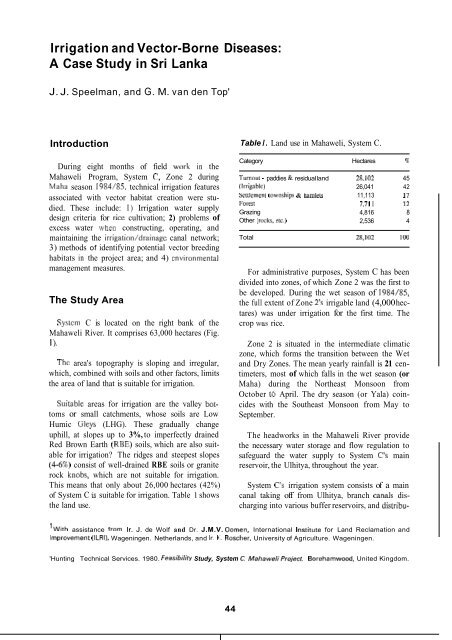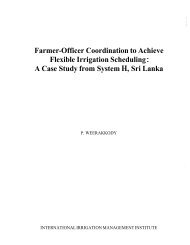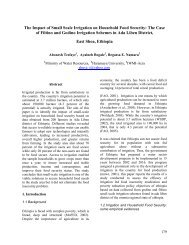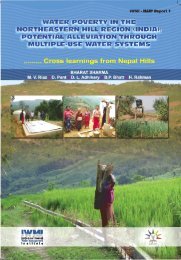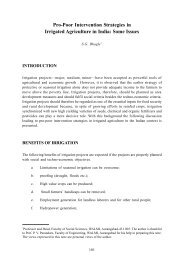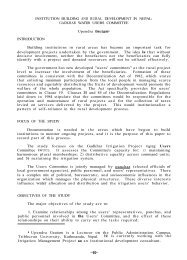Irrigation and Vector-Borne Diseases: A Case Study in Sri Lanka
Irrigation and Vector-Borne Diseases: A Case Study in Sri Lanka
Irrigation and Vector-Borne Diseases: A Case Study in Sri Lanka
Create successful ePaper yourself
Turn your PDF publications into a flip-book with our unique Google optimized e-Paper software.
<strong>Irrigation</strong> <strong>and</strong> <strong>Vector</strong>-<strong>Borne</strong> <strong>Diseases</strong>:<br />
A <strong>Case</strong> <strong>Study</strong> <strong>in</strong> <strong>Sri</strong> <strong>Lanka</strong><br />
J. J. Speelman, <strong>and</strong> G. M. van den Top'<br />
Introduction<br />
Dur<strong>in</strong>g eight months of field wurk <strong>in</strong> the<br />
Mahaweli Program, System C', Zone 2 dur<strong>in</strong>g<br />
Maha season 1984185, technical irrigation features<br />
associated with vector habitat creation were studied.<br />
These <strong>in</strong>clude: I) <strong>Irrigation</strong> water supply<br />
design criteria for rice cultivation; 2) problems of<br />
excess water when construct<strong>in</strong>g, operat<strong>in</strong>g, <strong>and</strong><br />
ma<strong>in</strong>ta<strong>in</strong><strong>in</strong>g the irrigatioddra<strong>in</strong>agc canal network;<br />
3) methods of identify<strong>in</strong>g potential vector breed<strong>in</strong>g<br />
habitats <strong>in</strong> the project area; <strong>and</strong> 4) cnvironmental<br />
management measures.<br />
The <strong>Study</strong> Area<br />
Systcm C is located on the right bank of the<br />
Mahaweli River. It comprises 63,000 hectares (Fig.<br />
1).<br />
The area's topography is slop<strong>in</strong>g <strong>and</strong> irregular,<br />
which, comb<strong>in</strong>ed with soils <strong>and</strong> other factors, limits<br />
the area of l<strong>and</strong> that is suitable for irrigation.<br />
Suitable areas for irrigation are the valley hottoms<br />
or small catchments, whose soils are Low<br />
Humic Gleys (LHG). These gradually change<br />
uphill, at slopes up to 3%, to imperfectly dra<strong>in</strong>ed<br />
Red Brown Earth fRBE) soils, which are also suitable<br />
for irrigation The ridges <strong>and</strong> steepest slopes<br />
(4-6%) consist of well-dra<strong>in</strong>ed RBE soils or granite<br />
rock knobs, which are not suitable for irrigation.<br />
This means that only about 26,000 hectares (42%)<br />
of System C is suitable for irrigation. Table 1 shows<br />
the l<strong>and</strong> use.<br />
Table I. L<strong>and</strong> use <strong>in</strong> Mahaweli, System C.<br />
Category Hectares *<br />
'Turnout - paddies & residual l<strong>and</strong> 28,102 45<br />
(Irrigable) 26,041 42<br />
Settlement townships & hamleu 11,113 17<br />
Forest 7,71 I 12<br />
Graz<strong>in</strong>g 4,816 8<br />
Other (rocks, CIC.) 2,536 4<br />
Total 28,1(12 100<br />
For adm<strong>in</strong>istrative purposes, System C has been<br />
divided <strong>in</strong>to zones, of which Zone 2 was the first to<br />
be developed. Dur<strong>in</strong>g the wet season of 1984/85,<br />
the full extent of Zone 2's irrigable l<strong>and</strong> (4,000 hectares)<br />
was under irrigation for the first time. The<br />
crop was rice.<br />
Zone 2 is situated <strong>in</strong> the <strong>in</strong>termediate climatic<br />
zone, which forms the transition between the Wet<br />
<strong>and</strong> Dry Zones. The mean yearly ra<strong>in</strong>fall is 21 centimeters,<br />
most of which falls <strong>in</strong> the wet season (or<br />
Maha) dur<strong>in</strong>g the Northeast Monsoon from<br />
October t6 April. The dry season (or Yala) co<strong>in</strong>cides<br />
with the Southeast Monsoon from May to<br />
September.<br />
The headworks <strong>in</strong> the Mahaweli River provide<br />
the necessary water storage <strong>and</strong> flow regulation to<br />
safeguard the water supply to System C's ma<strong>in</strong><br />
reservoir, the Ulhitya, throughout the year.<br />
System C's irrigation system consists of a ma<strong>in</strong><br />
canal tak<strong>in</strong>g off from Ulhitya, branch canals discharg<strong>in</strong>g<br />
<strong>in</strong>to various buffer reservoirs, <strong>and</strong> distribu-<br />
'With assistance from lr. J. de Wolf <strong>and</strong> Dr. J.M.V. Oomen. International Institute for L<strong>and</strong> Reclamation <strong>and</strong><br />
Improvement (ILRI). Wagen<strong>in</strong>gen. Netherl<strong>and</strong>s, <strong>and</strong> lr. 1.. Roscher. University of Agriculture. Wagen<strong>in</strong>gen.<br />
'Hunt<strong>in</strong>g Technical Services. 1980. Feasibiliry <strong>Study</strong>, System C. MahaweliProjeci. Barehamwood. United K<strong>in</strong>gdom.<br />
44
Figure 1. The Accelerated Mahaweli Development Project, System C, 1983.<br />
System C<br />
45
utary channels tak<strong>in</strong>g off from these rcscrvoirs <strong>and</strong><br />
convey<strong>in</strong>g water to the m<strong>in</strong>or irrigation units, or<br />
turnouts. Every Lurnout has one field channel runn<strong>in</strong>g<br />
downslope <strong>and</strong> serv<strong>in</strong>g between 5 <strong>and</strong> 20<br />
farmers, each own<strong>in</strong>g onc hcctarc allotmcnh of<br />
paddy lowl<strong>and</strong>. In addition, each settler family gets<br />
a 0.5 hectare homestead on which to cultivate other<br />
food crops.<br />
Public Health <strong>and</strong> <strong>Vector</strong>-<strong>Borne</strong><br />
<strong>Diseases</strong> <strong>in</strong> System C<br />
The major public health prohlcms be<strong>in</strong>g combatted<br />
by the <strong>Sri</strong> <strong>Lanka</strong>n authorities are malaria,<br />
gastro-enteritis, accidents, dysentery, <strong>and</strong> anemia.:'<br />
In System C, the most prevalent ailments are thos':<br />
related to poor hygiene <strong>and</strong> sub-st<strong>and</strong>ard liv<strong>in</strong>:<br />
conditions: malnutrition, water-washed disease!,<br />
respiratory diseases, <strong>and</strong> vector-borne diseases<br />
(Table 2).<br />
Table 2. Some data on public health <strong>in</strong> System C,<br />
1983-84.<br />
Disenss treated 1983 (%) 1984 ('#)<br />
Respiratory <strong>in</strong>fections<br />
Warm <strong>in</strong>festations<br />
Sk<strong>in</strong> iifections<br />
Malnutrition<br />
Bowel <strong>in</strong>fections<br />
Genita-ur<strong>in</strong>ary <strong>in</strong>fections<br />
Accidents<br />
Cl<strong>in</strong>ically detected malaria<br />
Cardiovascular conditions<br />
Filarial <strong>in</strong>fections<br />
Othcr illnacs<br />
20.6<br />
16.8<br />
13.6<br />
12.2<br />
11.5<br />
9.0<br />
6.9<br />
4.4<br />
0.5<br />
0.3<br />
4.2<br />
21.3<br />
16.)<br />
12.7<br />
11.5<br />
14.5<br />
6.1<br />
5.4<br />
8.)<br />
0.4<br />
0. $<br />
2.9<br />
Total cases tread 37,551 46,531<br />
The most serious vector-borne diseases are malaria,<br />
filariasis, dengue, <strong>and</strong> Japanese &encephalitis.<br />
Mulariu. Countrywide figures show an average<br />
of 7% of the exam<strong>in</strong>ed blood films ti1 cimtaiti malaria<br />
parasites, with <strong>in</strong>cidences of 12'2 <strong>in</strong> 198.1 <strong>and</strong><br />
17% <strong>in</strong> 1984. In <strong>Sri</strong> <strong>Lanka</strong>. the sole proven vcctor<br />
of malaria is Anophda culcifaci
Measures <strong>in</strong>cluded <strong>in</strong> the present program of<br />
controll<strong>in</strong>g vcctor-borne diseases are: <strong>in</strong>door <strong>in</strong>secticide<br />
spray<strong>in</strong>g <strong>and</strong> medical treatment of rccognized<br />
cases, particularly of malaria. In the endemic belt,<br />
the Anti-Filariasis Campaign regularly sprays larvicides<br />
on the potential breed<strong>in</strong>g places of the filariasis<br />
vector. For the follow<strong>in</strong>g reasons, however, there<br />
is an urgent need for a more diversified, <strong>and</strong> therefore<br />
less vulnerable, long-term control of vectorborne<br />
diseases:<br />
1. The <strong>in</strong>creased human mobility <strong>in</strong> <strong>and</strong> out of<br />
the Project area is promot<strong>in</strong>g the transmission of<br />
vector-borne disease^.^ The <strong>in</strong>tensity of transmission<br />
is likely to change with the chang<strong>in</strong>g microclimatc,<br />
vegetation, animal population, number of<br />
waterways, <strong>and</strong> other environmental chan es now<br />
be<strong>in</strong>g <strong>in</strong>troduced by development activities. i<br />
2. Neither the Anti-Malaria nor the Anti-<br />
Filariasis Campaigns have sufficient funds or man-<br />
power to <strong>in</strong>tensify their activities <strong>in</strong> the Mahaweli<br />
Project areas.'<br />
2. The present vector control by spray<strong>in</strong>g is not<br />
entirely effective because: a) An estimated 40%'' of<br />
the System C population are display<strong>in</strong>g an <strong>in</strong>creas<strong>in</strong>g<br />
unwill<strong>in</strong>gness to have their houses sprayed<br />
because of the unpleasant smell <strong>and</strong> the fear that it<br />
has an adverse effect on health; <strong>and</strong> b) pools used<br />
by humans <strong>and</strong> animals must be excluded from<br />
sprxy<strong>in</strong>g because of the risk of the pools becom<strong>in</strong>g<br />
poi:;oued.<br />
4.. The heavy reliance on chemicals to control<br />
vector-borne diseases makes the Campaigns vulnerablt:<br />
because of the pace at which vector mosquitoe!;<br />
develop resistance to the chemicals."<br />
Figure 2 shows the concept on an <strong>in</strong>tegrated control<br />
that has been developed to meet the need for<br />
more diversified approaches to vector control. This<br />
Figure 2. Diagram of the components to be considered <strong>in</strong> an "Integrated Control" approach to mosquito<br />
controla'<br />
a'Axtell. R. C. 1979. Pr<strong>in</strong>ciples of Integrated Pest Management (IPM) <strong>in</strong> relation to mosquito control. Mosquito News<br />
39:709-718.<br />
'Fern<strong>and</strong>o, M. (ed.). 1984. Human Population Movements <strong>and</strong> ,'heir Impact on Tropical Disease, Transmission <strong>and</strong><br />
Controlm <strong>Sri</strong> <strong>Lanka</strong>. Proceed<strong>in</strong>gs of a Workshop. University of Pwadeniya, Faculty of Medic<strong>in</strong>e; the World Bank; <strong>and</strong><br />
the World Health Organization (WHO).<br />
'TAMS (Tippets, Abbett, McCarthy. <strong>and</strong> Stratton). 1980. Enviro.7mental Assessment Accelerared Mahaweli Developmenr<br />
Programme (for M<strong>in</strong>istry of Mahaweli Development). New York.<br />
'Anti-Malaria Campaign. 1978-83. Adm<strong>in</strong>istration Reports. Co ombo: M<strong>in</strong>istry of Health <strong>and</strong> Anti-Filariasis Campaign.<br />
1978-78. Adm<strong>in</strong>isriation Reports. Mount Lav<strong>in</strong>ia: M<strong>in</strong>istry of Health.<br />
"Based on an Anti-malaria Campaign field staff report.<br />
l1 Several of the suspected new malarla vectors have already developed multiple resistance tothe <strong>in</strong>secticides now<br />
available (see ref. footnote 4).<br />
47
~~~~ ~~~ ~ ~~~~<br />
concept comb<strong>in</strong>es chemical. biological, <strong>and</strong> environmental<br />
management methods that suit the local<br />
requirements <strong>and</strong> possibilities. In Zone 2, where the<br />
irrigation systems determ<strong>in</strong>es the environment <strong>in</strong> a<br />
large part of the area, the analysis <strong>and</strong> possible<br />
improvement of present water-management practicies<br />
form an essential element <strong>in</strong> environmental<br />
management for vector control.<br />
Identify<strong>in</strong>g <strong>Vector</strong><br />
Habitats <strong>in</strong> Zone 2<br />
Whether water forms a suitable breed<strong>in</strong>g place<br />
for vectors depends on a variety of factors. In irri-<br />
gated agriculture, a relationship has to be established<br />
between observed water bodies, the practices<br />
that led to their creation, <strong>and</strong> whether they will<br />
cause the proliferation of specific vectors. To establish<br />
this relationship <strong>in</strong> Zone 2, three matrices werc<br />
developed<br />
Matrix I. Potential mosquito breed<strong>in</strong>g places<br />
were classified by adapt<strong>in</strong>g the system described <strong>in</strong><br />
the WHO Manual on Environmental Management<br />
for <strong>Vector</strong> Control to the local situation. The stagnant<br />
bodies of water cncountercd <strong>in</strong> Zone 2 were<br />
placed <strong>in</strong> one of seven categories (Table 3). accord<strong>in</strong>g<br />
to criteria such as organic pollution, exposure to<br />
sunlight, vegetation, freshness of the water, <strong>and</strong> the<br />
size of the pool.<br />
Table 3. Classification of the most common potentirl breed<strong>in</strong>g places <strong>in</strong> System C, Zone 2<br />
A. Large bodies of fmh water <strong>in</strong> full or partial sunlight (float<strong>in</strong>g JT emergent vegetation occurs especially near thc edges):<br />
1. Ulhitya/Ratki<strong>in</strong>da reservoir, irrigation tanks, level cr0ss<strong>in</strong>;:s; largc borrow pits, waterlogged pools beh<strong>in</strong>d filled D-channel bunds,<br />
large natural surface depressions.<br />
2. Marshes.<br />
B. Small watcr collections, stagnant <strong>and</strong> often muddy, but not polluted; full to partial sunlight:<br />
1. Vegetation present (scattercd or fr<strong>in</strong>ged): Marg<strong>in</strong>al pockets along irrigation canals, semi permanent ra<strong>in</strong> pools <strong>in</strong> natural or<br />
man-made surfacc depressions (e.g., <strong>in</strong> bctween road <strong>and</strong> cmal bund), seepage pools beh<strong>in</strong>d tank or cilnal bund, old borrow pits,<br />
clogged dra<strong>in</strong>age ditchcs.<br />
2. Vcgctation absent: Recent borrow pits, rock pools on excavation sites, new road ditches, wheel rub, foot- or hoof-pr<strong>in</strong>ts, ra<strong>in</strong> water<br />
ground pools.<br />
C. Marshy patches, often polluted with organic matter; aliundant vcgetation (oily mono-layen, ironsolured water, smell of<br />
decomposition):<br />
1. Marg<strong>in</strong>s of level crasi<strong>in</strong>gs, seepage pondsldepressions ;long irrigation canals constructed <strong>in</strong> fill. poorly dra<strong>in</strong>ed, shallow but<br />
extensive surface depressions.<br />
2. Roads saturated with water overflow<strong>in</strong>g from field channes<br />
3. Muddy broad sections of natural dra<strong>in</strong>s where the waler flmw stagnates (ma<strong>in</strong>ly <strong>in</strong> upper parts 01 <strong>in</strong>termediate dra<strong>in</strong>s)<br />
D. Paddy fields.<br />
1. Swampy, poorly dra<strong>in</strong>ed fallow lowl<strong>and</strong> paddy fields befo e l<strong>and</strong> preparation<br />
2. Recently tilled fields.<br />
3. Fields dur<strong>in</strong>g seed<strong>in</strong>g (levelled tields, no water layer, but s<strong>in</strong>all shallow pools)<br />
4. Field7 dur<strong>in</strong>g transplant<strong>in</strong>g (levelled fields, shallow water).<br />
Cont<strong>in</strong>ued<br />
48
Matrix I1 From direct observation of the irriga.<br />
tion system <strong>and</strong> of agricultural practices, <strong>and</strong> from<br />
other <strong>in</strong>formation, we identified (Fig. 4) the po<strong>in</strong>t<br />
<strong>in</strong> the irrigation system (eg., reservoir, ma<strong>in</strong> canal,<br />
etc.) <strong>and</strong> <strong>in</strong> the irrigation cycle (e.g., pre-irrigation,<br />
l<strong>and</strong>-preparation, etc.) where the various breed<strong>in</strong>g:<br />
places become an important hazard to health.<br />
Matrix 111 thus completes the stepwise cause<strong>and</strong>-effect<br />
analysis, which starts with identify<strong>in</strong>g the<br />
vector <strong>and</strong> ends with identify<strong>in</strong>g the irrigation feature<br />
that <strong>in</strong>fluences vector habitat. Although the<br />
matrices still need more data from both irrigation<br />
<strong>and</strong> entomology, they provide a framework for<br />
further study of the l<strong>in</strong>kage between irrigation <strong>and</strong><br />
Figure 4. Matrix I t Location of potential breed<strong>in</strong>g places.<br />
Pre- L<strong>and</strong>- Crop Vegetative Harvest post-<br />
<strong>Irrigation</strong> Preparation Establishment Growth <strong>Irrigation</strong><br />
Reservoir Al, GI Al, GI Al, GI Al, GI Al, ti1 Al, GI<br />
MaidBranch Canal F1 F3 F3 F3 F3 Fl<br />
Buffer Reservoirs A2 AI:BI;CI AI;BI;CI A1;BI:CI AI:BI,CI A2<br />
Distributary AI;CI;GI AI:Bl,2 Al;BL,2 AI;B1,2 AI;til;CI AI;GI,CI<br />
Channel FI F3;EI F3;EI F3;EI FI FI<br />
Field Channel CI:F1 BI;C1,2 BI;C1,2 Bl:CI,Z CI;FI CI;FI<br />
Field Ditch F2 F2 F2<br />
Field D1 D2,6 D3,4,6 D5.h Dh D1<br />
Field Dra<strong>in</strong>age F2 BI;F2 Bl;F2 Bl;F2<br />
Natural stream EI;FI C3;E2 C3E2 C3;E2 CXE2 El<br />
Domestic Environ. G2 G2 G2 G2 G2 G2<br />
Natural Enwron. AI;B1,2 AAI;B1,2 AI;BI,2 AI:B1,2 AI:B1,2 A1:B1,2<br />
CI CI CI CI CI CI<br />
Matrix I1 thus <strong>in</strong>dicates the relative importance<br />
of the irrigation system as a whole for potential vec.<br />
tor breed<strong>in</strong>g <strong>in</strong> the area, <strong>and</strong> s<strong>in</strong>gles out those ele.<br />
ments of the irrigation system that contribute mos:<br />
to the breed<strong>in</strong>g risk.<br />
Matrix III. Matrir 111 establishes the relationshill<br />
between the location of the breed<strong>in</strong>g places ant1<br />
those features of water management <strong>and</strong> irrigatiorl<br />
eng<strong>in</strong>eer<strong>in</strong>g that cause their existence: hydrology,<br />
design, construction, etc. (Fig. 5).<br />
vector ecology under the specific environmental<br />
conditions of Zone 2.<br />
<strong>Irrigation</strong> Features Related<br />
to <strong>Vector</strong> Habitat Creation<br />
Matrix I11 directs attention to that feature of the<br />
irrigation system, which, by an analysis of its<br />
details, will prove to be the cause of a particular<br />
type of breed<strong>in</strong>g place. Even so, a general rule<br />
Figure 5. Matrix I11 Relationship between breed<strong>in</strong>g place <strong>and</strong> irrigation feature.<br />
Hydrology Farm-Water Deslgn Construction Operation Ma<strong>in</strong>tenance<br />
Management<br />
Reservoir<br />
MaidBranch Canal<br />
Buffer Reservoirs<br />
Distributary<br />
Channel<br />
Field Channel<br />
Field Ditch<br />
Field<br />
Field Dra<strong>in</strong>age<br />
Natural stream<br />
Domatic Enviran.<br />
Natural Environ.<br />
Al<br />
A%Cl<br />
AI:Bl<br />
AI;BI<br />
Bt<br />
AI;C3;EI<br />
QFI<br />
AI;BI;CI<br />
m<br />
D1.6<br />
F2<br />
Gt A1 A1<br />
F3 F1,3<br />
Bl A1 A1<br />
AI;EI Al$l,Z;Cl C1 B1;CI;FI<br />
GI EI;FIQ F3<br />
FI BI:Cl,Z;Fl BI;CI,Z;FI BI;CI<br />
F2<br />
F2<br />
BI<br />
C3;EI,2<br />
G2<br />
B2<br />
BI;F2<br />
C3;EI.Z<br />
G2<br />
B2<br />
50
seems to apply: the more carefully <strong>and</strong> m<strong>in</strong>utely<br />
irrigation development is planned <strong>and</strong> executed, the<br />
less likely it is to encourage mosquito propagation.<br />
Some examples of the pr<strong>in</strong>ciples under-ly<strong>in</strong>g this<br />
rule were observed <strong>in</strong> Zone 2.l' Hydrology. The<br />
slop<strong>in</strong>g <strong>and</strong> irregular topography of System C has<br />
imposed two major constra<strong>in</strong>ts on the dra<strong>in</strong>age of<br />
the area. First, dra<strong>in</strong>age of the large area of l<strong>and</strong><br />
excluded from the irrigation scheme would have<br />
required a large number of culverts <strong>and</strong> other devices<br />
because, <strong>in</strong> many cases, the newly constructed<br />
roads <strong>and</strong> canal bunds have cut off stretches of this<br />
l<strong>and</strong> from the natural dra<strong>in</strong>s.<br />
Second, numerous small unirrigable patches are<br />
scattered with<strong>in</strong> the irrigation system's boundaries.<br />
These conta<strong>in</strong> natural <strong>and</strong> man-made surface<br />
depressions that do not dra<strong>in</strong> to the dra<strong>in</strong>age network<br />
laid out as part of the irrigation system. These<br />
depressions collect water from blocked natural<br />
dra<strong>in</strong>age, ra<strong>in</strong>fall, surface runoff, <strong>and</strong> seepage, to<br />
create large <strong>and</strong> small, often brightly sunlit, bodies<br />
of stagnant water that reta<strong>in</strong> an overall breed<strong>in</strong>g<br />
potential for the area throughout all phases of the<br />
irrigation cycle.<br />
Design. A complex network of reservoirs <strong>and</strong><br />
major <strong>and</strong> m<strong>in</strong>or canals resulted from the policy of<br />
creat<strong>in</strong>g the largest possible comm<strong>and</strong> area <strong>in</strong> the<br />
undulat<strong>in</strong>g topography <strong>and</strong> vary<strong>in</strong>g soil conditions<br />
of System C. The control of water flows <strong>in</strong> all parts<br />
of this network is, <strong>in</strong> itself, a complex matter, which<br />
places heavy dem<strong>and</strong>s on the staff operat<strong>in</strong>g the<br />
system. The situation is further complicated by the<br />
decision to leave canals unl<strong>in</strong>ed, with all the<br />
attendant problems of erosion <strong>and</strong> seepage.<br />
of tiis erosion is the deposition of silt, which, <strong>in</strong> the<br />
pre. <strong>and</strong> post-irrigation periods, leads to uneven<br />
can11 beds with many shallow sunlit pools of stagnant<br />
water. In consequence, conditions <strong>in</strong> the distributaries<br />
<strong>and</strong> branches are particularly conducive<br />
to )he development of mosquito larvae until Ibe<br />
firs1 issue of water, after which a constant flow is<br />
ma<strong>in</strong>ta<strong>in</strong>ed <strong>in</strong> the canals. Potential breed<strong>in</strong>g areas<br />
rema<strong>in</strong>, however, where erosion gullies <strong>in</strong> bunds<br />
form pockets of st<strong>and</strong><strong>in</strong>g water.<br />
Ekpecially <strong>in</strong> the m<strong>in</strong>or canals, there are two<br />
oth8:r effects of bund erosion: First, over the full<br />
lenl:th of the field channels <strong>and</strong> at the tail end of<br />
distributaries, the deposition of silt caws capacity<br />
problems. The subsequent overtopp<strong>in</strong>g of canal<br />
embankments leads to pool formation <strong>in</strong> adjo<strong>in</strong><strong>in</strong>g<br />
suriace depressions. Second, accelerated water flow<br />
<strong>and</strong> whirlpool action occurr<strong>in</strong>g downs-tream of<br />
cul./erts, bridges, drop <strong>and</strong> check structures, <strong>and</strong><br />
bends, cause bank erosion. This widens the canal<br />
crowsection, retards water flow, <strong>and</strong> creates breed<strong>in</strong>g<br />
places <strong>in</strong> the side pockets along the embankmeit.<br />
In contrast, the large Ulhitya Reservoir cannot<br />
be reckoned as a dangerous breed<strong>in</strong>g place. The<br />
rescwoir bund closest to the nearest settler hamlet<br />
exceeds the average flight range of most mosquito<br />
vectors: 1-3 kilometers.<br />
Ilulike Ulhitya, the score of smaller irrigation<br />
rewvoirs <strong>in</strong>corporated <strong>in</strong> the system (<strong>and</strong> <strong>in</strong> proximity<br />
to human habitation) may contribute considerably<br />
to vector breed<strong>in</strong>g. Often the embankments<br />
F&re 6. Example of canal layout <strong>in</strong> System C.<br />
The design of separate parts of the system may<br />
create public health hazards. Figure 6 gives an<br />
example of how the canal layout has been adapted<br />
to the topography.<br />
Distributary canals are aligned along the lateral<br />
spurs of the ma<strong>in</strong> ridges, which means that a major<br />
part of every distributary runs through the imperfectly<br />
to well-dra<strong>in</strong>ed RBE soils. Where these<br />
canals have been excavated <strong>in</strong> erodible RBE soils,<br />
serious bund erosion has been observed. One effect<br />
"We should emphasize that development <strong>in</strong> the project area is Still <strong>in</strong> a transitional phase. The chang<strong>in</strong>g environmental<br />
<strong>and</strong> other conditions may, <strong>in</strong> the long run, <strong>in</strong>fluence the i'elative importance of the observed causes of vector<br />
habitat creation.<br />
3World Health Organization. 1982. Manual on Environmenfalll~~nagpmenf for Mosquito Confrol. Geneva, Switzerl<strong>and</strong>:<br />
WHO pub. 66. pp281.<br />
51
of small irrigation reservoirs (or tanks) are <strong>in</strong>festcid<br />
with emergent or float<strong>in</strong>g vegetation, of which Sclv<strong>in</strong>ia<br />
natans is a suspected breed<strong>in</strong>g requisite for<br />
Mansonia spp.., thevector of Brugian filariasis.<br />
These small reservoirs serve the purpose of buffer<strong>in</strong>g<br />
the effects of disproportion between fr,:-<br />
quency of adjustments <strong>in</strong> major <strong>and</strong> m<strong>in</strong>or canals.<br />
Water levels, therefore, are subject to irregular flu,;-<br />
tuations throughout the year, caus<strong>in</strong>g an exposfd<br />
drawback zone suitable for mosquito breed<strong>in</strong>g each<br />
time the water recedes. If the drawback zone dois<br />
not consist of isolated small depressions, however,<br />
the shallows will empty when the water recedes,<br />
leav<strong>in</strong>g the eggs, larvae, <strong>and</strong> pupae str<strong>and</strong>ed.<br />
Conslruction. S<strong>in</strong>ce 1977, the Mahaweli Development<br />
Programme has been "accelerated," which<br />
means that the tempo was <strong>in</strong>creased <strong>in</strong> constructirg<br />
headworks <strong>and</strong> open<strong>in</strong>g .new l<strong>and</strong>s to irrigation.<br />
This <strong>in</strong>creased tempo also meant that shortagm<br />
were encountered, <strong>in</strong>clud<strong>in</strong>g: 1) Accurate topogr;iphical<br />
maps of the new l<strong>and</strong>s to be developed, z!)<br />
expertise <strong>and</strong> management for plann<strong>in</strong>g <strong>and</strong> monitor<strong>in</strong>g<br />
construction, 3) well-equipped <strong>and</strong> expcrienced<br />
local contractors for execut<strong>in</strong>g the work,<br />
<strong>and</strong> 4) supplies of high-quality construction<br />
materials.<br />
The effects of these shortages are now appear<strong>in</strong>g<br />
<strong>in</strong> the irrigation <strong>in</strong>frastructure. Examples <strong>in</strong>clude<br />
the follow<strong>in</strong>g:<br />
1. Not all the canal beds <strong>and</strong> structures hale<br />
been constructed at the proper elevations. The<br />
result is <strong>in</strong>correct water flows, stagnation of<br />
water <strong>in</strong> canal sections, <strong>and</strong> overtopp<strong>in</strong>g of<br />
bunds, with the consequent formation of poo s<br />
<strong>in</strong> adjo<strong>in</strong><strong>in</strong>g depressions.<br />
2. Some canal sections have been constructed t~<br />
fill, without be<strong>in</strong>g compacted, which is necessary<br />
to avoid seepage <strong>and</strong> leakage. This has led to the<br />
cont<strong>in</strong>uous presence of adjacent waterlogged SUI'-<br />
face depressions.<br />
3. Complicated construction works such as large<br />
culverts, water-level regulat<strong>in</strong>g structures, aquc:-<br />
ducts, <strong>and</strong> <strong>in</strong>verted syphons have not all been<br />
made with the highquality materials they<br />
require, nor have they all been accurately<br />
<strong>in</strong>stalled. This is necessary not only to prevent<br />
the creation of breed<strong>in</strong>g places, but also to safeguard<br />
the delivery of design water flows<br />
throughout the system.<br />
Operation. The quality of the design <strong>and</strong> construction<br />
determ<strong>in</strong>es the boundary conditions<br />
with<strong>in</strong> which operational procedures are laid down<br />
that supposedly guarantee a uniform <strong>and</strong> reliable<br />
supply of sufficient irrigation water. In System C,<br />
the accelerated implementation of a complex design<br />
under difficult topographical conditions has resulted<br />
<strong>in</strong> complicated operational procedures that have<br />
not been able to prevent shortages or excesses of<br />
water.<br />
Accord<strong>in</strong>g to Moore,14 the cause of many of the<br />
problems <strong>in</strong> large-scale irrigation schemes <strong>in</strong> <strong>Sri</strong><br />
<strong>Lanka</strong> lies <strong>in</strong> the operational procedures applied,<br />
which rank low <strong>in</strong> formality, <strong>in</strong>formation, <strong>and</strong> control.<br />
His contention also holds for Zone 2.<br />
Formality. The formality of operation <strong>in</strong> Zone 2<br />
is characterized by: a) An almost total lack of written<br />
technical procedures for the adjustment of control<br />
gates downstream of the ma<strong>in</strong> canal; b) the<br />
absence of explicit job descriptions for water management<br />
staff; <strong>and</strong> c) poor coord<strong>in</strong>ation of policies<br />
<strong>and</strong> activities, lead<strong>in</strong>g to haphazard implementation<br />
of ra<strong>in</strong>fall corrections, rotation schedules,<br />
cropp<strong>in</strong>g calendars, etc.<br />
In circumstances like this, an alert <strong>and</strong> effective<br />
water management for the equitable distribution of<br />
irrigation water is impossible. The result is that<br />
farmers <strong>and</strong> water management staff are becom<strong>in</strong>g<br />
alienated. Poach<strong>in</strong>g water <strong>and</strong> damag<strong>in</strong>g irrigation<br />
structures are common actions when farmers feel<br />
that their compla<strong>in</strong>ts about water shortages are not<br />
heard.<br />
Information Flow measurements are imperative<br />
if one is to verify channel flow <strong>and</strong> locate faulty<br />
design or construction <strong>in</strong> the canal system. Flows <strong>in</strong><br />
the ma<strong>in</strong> <strong>and</strong> branch canals or Zone 2 are measured<br />
with Parshall flumes, <strong>and</strong> <strong>in</strong> the distributaries<br />
with short-crested (hump) weirs. Only a m<strong>in</strong>imum<br />
number of measurement devices, however, have<br />
l4Moore. M.P. 1980. Approaches to Improv<strong>in</strong>g Water Management on Large-scale <strong>Irrigation</strong> <strong>in</strong> <strong>Sri</strong> <strong>Lanka</strong>. Colombo:<br />
Agrarian Research <strong>and</strong> Tra<strong>in</strong><strong>in</strong>g Institute (ARTI) Occasional Pub. 20. pp47<br />
52
een <strong>in</strong>corporated <strong>in</strong> the canal network, <strong>and</strong> many<br />
of them cannot he used for accurate read<strong>in</strong>gs<br />
because of improper elevation or the absence of a<br />
read<strong>in</strong>g gauge. At present, the only records that are<br />
kept are those of the ma<strong>in</strong> sluice. Further down the<br />
system, unrecorded "guesstimates" from improvised<br />
methods are used for adjust<strong>in</strong>g m<strong>in</strong>or irrigation<br />
structures.<br />
Control. Discrcpancics between water requirements<br />
<strong>and</strong> actual amounts issued are <strong>in</strong>herent <strong>in</strong><br />
irrigation. Some soils are more porous than othcrs,<br />
while differences <strong>in</strong> canal topography. length, <strong>and</strong><br />
ma<strong>in</strong>tenance may mean that two adjacent canals<br />
require very different - but hard to assess - amounts<br />
of water at their head ends to ensure supplies to<br />
their tail ends.<br />
Another factor is the degree of control it is possible<br />
to exercise over the water flows. In Zone 2,<br />
from distributary level down to the fields, the vertical<br />
sluice-gate <strong>in</strong>let structures are adjustable, but<br />
they cannot he sufficiently f<strong>in</strong>e-tuned to guarantee<br />
the required flow (see footnote 2). Dur<strong>in</strong>g ra<strong>in</strong>fall<br />
of more than 8 centimeters, for example, the ma<strong>in</strong><br />
flow can he accurately cut hack for one week to<br />
50%. From the distributaries downward, however,<br />
the adjustments can only he approximated, which is<br />
likely to starve tail-end distributaries of water.<br />
Furthermore, ra<strong>in</strong>-fall is unevenly distributed over<br />
Zone 2. Because data from only one ra<strong>in</strong> gauge are<br />
used, canals at the tail ends of the system sometimes<br />
dry up.<br />
At turnout level, farmers have difficulty controll<strong>in</strong>g<br />
the water issues. Dur<strong>in</strong>g l<strong>and</strong> preparation,<br />
the system operates at full capacity, deliver<strong>in</strong>g a<br />
cont<strong>in</strong>uous flow of roughly 30 liters per second to<br />
every turnout gate. But the number of farmers<br />
under one turnout varies widely, lead<strong>in</strong>g to overirrigation<br />
at the smaller turnouts. This, <strong>in</strong> comb<strong>in</strong>ation<br />
with local dra<strong>in</strong>age problems, causes l<strong>and</strong> to<br />
he <strong>in</strong>undated for several weeks at a time.<br />
Along the field channels, three farmers must<br />
share the design flow by us<strong>in</strong>g two-outlet boxes,<br />
one of which rema<strong>in</strong>s half-closed. Such a discrepancy<br />
between design <strong>and</strong> rotational procedure<br />
cripples any endeavor to achieve an equitable distribution<br />
of water with<strong>in</strong> the turn-out.<br />
Too much water was issued as a palliative for<br />
thelie shortcom<strong>in</strong>gs dur<strong>in</strong>g thc wet scason 19x4-85.<br />
anc this disguised the need for urgently required<br />
construction, reorgani7.ation, <strong>and</strong> ma<strong>in</strong>tenance<br />
with<strong>in</strong> thc system. Other risks attendant on an<br />
overgenerous supply of water arc that farmers<br />
become wedded to lavish waler use <strong>and</strong> lose their<br />
abi ity to h<strong>and</strong>le water as a scarce commodity or to<br />
manage rotational water deliveries. both undoubted1.i<br />
lead<strong>in</strong>g to the creation of vector breed<strong>in</strong>g<br />
pla1;cs.<br />
Once a vector habitat has been identified somewh:re<br />
<strong>in</strong> the system, it is difticult to determ<strong>in</strong>e<br />
wh:ther ,its occurrence is related to one specific<br />
opmitional feature. Operational short-com<strong>in</strong>gs tend<br />
to have a cumulative effect. This, however, does not<br />
derogate from the general rule that the morc cuefully<br />
the m<strong>in</strong>utely irrigation development is planned<br />
<strong>and</strong> executed, the less likely it is to cause mosquito<br />
prcpagation.<br />
Mu<strong>in</strong>tenunce. Wherever ma<strong>in</strong>tenancc of an irrigation<br />
system is neglected, water flows will he<br />
retarded, areas will he <strong>in</strong>undated, <strong>and</strong> other processes<br />
favorable to the formation of pools of st<strong>and</strong><strong>in</strong>g<br />
water are likely to take place. Ma<strong>in</strong>tenancc<br />
work <strong>in</strong> Zone 2 is not well-organized, ma<strong>in</strong>ly<br />
hec:ause of the lack of consensus on responsibilities<br />
at Ihc <strong>in</strong>stitutional <strong>and</strong> turnout levels.<br />
At the <strong>in</strong>stitutional level, the construction of the<br />
system by one agency <strong>and</strong> the subsequent transfer<br />
of project management to another has not resulted<br />
<strong>in</strong> effective ma<strong>in</strong>tenance. For the first two years<br />
after construction, ma<strong>in</strong>tenance is the responsibility<br />
of the construction agency, hut with construction<br />
still <strong>in</strong> progress <strong>in</strong> other parts of the System C. <strong>and</strong><br />
<strong>in</strong> System B as well, this agency is hav<strong>in</strong>g difficulty<br />
<strong>in</strong> releas<strong>in</strong>g the manpower <strong>and</strong> mach<strong>in</strong>ery needed<br />
for ma<strong>in</strong>tenance <strong>in</strong> Zone 2.<br />
4t turnout level, the operation, <strong>and</strong> ma<strong>in</strong>tenaice<br />
of the <strong>in</strong>frastructure is left to the farmers.<br />
They elect a farmer-leader to represent them <strong>and</strong><br />
to see that works are executed accord<strong>in</strong>g to<br />
agi.eed-upon procedures. The farmer-leader, howewr,<br />
lacks the authority to enforce the rule Ithat<br />
ewry farmer must clean the canal section adjo<strong>in</strong><strong>in</strong>):<br />
his or her paddy plot, so not all farmers do<br />
thcir share of the work. The result is excessive<br />
plant growth <strong>in</strong> the canals, damaged canal bonds,<br />
<strong>and</strong> silted canal beds.<br />
53
Anothcr factor conipliczzt<strong>in</strong>g cooperation at t!ie<br />
turnout is hiddcn tenancy, which makes the ownership<br />
of some plots ~nclcar.~<br />
On-jarm Warer Munugemmt <strong>and</strong> Crop Hurhi<strong>in</strong>dry.<br />
Two methods of rice cultivation are pra,:.<br />
ticed <strong>in</strong> Zone 2. One is the "transplant<strong>in</strong>g" metho
givcn to iil(irc complcx cii\~ironmcntal nianagcnicnl<br />
iiieiiures lor vcctor ci<strong>in</strong>trol. Given thc present<br />
tecliiiicii! md iirpani7.ationaI level or water man-<br />
;igcmciit iii Zone 2. howcver. such measures are not<br />
yet rclcwiit.<br />
111 <strong>Sri</strong> I.anka, it Is iiou <strong>in</strong>creas<strong>in</strong>gly be<strong>in</strong>g rcc1,gniicd<br />
that the mcdical pro!zssion ciiiiriot he hcld<br />
solely rcyx<strong>in</strong>sihle for rc<strong>in</strong>rdid action aga<strong>in</strong>st the<br />
health ri\ks <strong>in</strong>troduccd hy eng<strong>in</strong>eers. What i\<br />
iiecdcd lor thc long-term control of vector-borne<br />
diseases is <strong>in</strong>ter-sectoral collaboration hemeen the<br />
eng necr<strong>in</strong>g <strong>and</strong> the medical professions - at m<strong>in</strong>ister<br />
al level <strong>and</strong> at project level. This is a prerequisite<br />
to the <strong>in</strong>corporation of preventive measures <strong>in</strong><br />
the dcsign <strong>and</strong> managenicnt of irrigation projects.<br />
I1 (he process of establish<strong>in</strong>g <strong>in</strong>tegrated control<br />
of tlisease vcctors <strong>in</strong> Zone 2 - <strong>and</strong> <strong>in</strong> other parts of<br />
the Mahaweli Project - irrigation water management<br />
would he a good place to start.<br />
55


